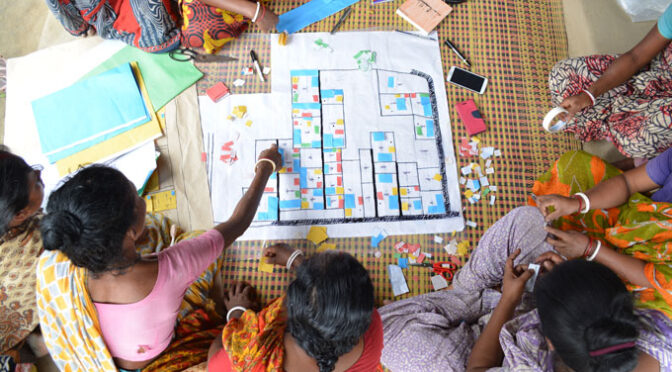Placemaking through grassroots initiatives and external actor engagement
By Mohammad Arfar Razi
Introduction
In an overpopulated country like Bangladesh, where development projects embrace ideas from western countries, it is not easy to imagine a community-led development effort. However, through the project Sobai Mile Jhenaidah Gori (translated as ‘let’s build Jhenaidah together’), residents are transforming the south-western Bangladeshi town of Jheniadah into a model cityscape by engaging with local government, several local NGOs, international thinkers, and many volunteer groups. Initiated by a local architect couple, Khondaker Hasibul Kabir and Suhailey Farzana, the project has changed a riverside into a public space with pedestrian routes, gardens, and cultural amenities. Many residents have also built homes here for far less than the cost of building in some slum areas through community-based financing initiatives. In addition, residents and community partners are further planning to improve the quality of life by designing pedestrian walkways, bicycle lanes, and wide green roads. The community-engagement process and design have garnered much acclaim, receiving the Aga Khan Award for Architecture in 2022.
Analysis
Although most of the urban expansion of the twenty-first century is occurring in the Global South, dominant urban theories have their roots in the developed world (Roy, 2006). In order to contest the colonial influence in the continual shaping of history and geographies (Roy, 2006) of a country like Bangladesh, visionary urbanists and planners such as Hasibul Kabir and Farzana have developed other alternatives based on everyday urbanism and co-production. Social movements have a crucial role in defining the material configuration of society, including poverty reduction, foreign assistance mobilization, effective governance, community development, and functioning democracy (Chowdhury, 2022). The Sobai Mile Jhenaidah Gori movement of Jhenaidah has become a successful example of poverty reduction, self-governance (Nunbogu, Korah, Cobbinah, & Poku-Boansi, 2018), and community development, and brought a tremendous number of positive externalities.
The original goal of the initiative was to create a community-driven method to construct housing models. Because of the severe problems associated with housing provision and the potential social conflict due to significant inequalities, bottom-up development (Nunbogu, Korah, Cobbinah, & Poku-Boansi, 2018) was seen as necessary in order to involve community members in the process. With technical assistance from community architects, women in the neighborhood convened to make a map of the new development, allowing them to conceptualize their ideal house and better understand the size and layout of their plots. Residents expressed different wishes—some wanted a second story, a flat roof for their kids to play on, or two rooms for larger families—leading architects to develop models of a single-story and a two-story house following the requirements of residents. As Nunbogu et al. (2018) suggest in their research on self-governance in Ghana, this co-production approach allowed residents to take the initiative and coordinate their efforts, contributing significantly to the project’s success.
Later, a community-led design of a ghat (gorge) led to the development of pathways hugging the Nabaganga riverbank in the city’s center, providing safe and environmentally sound access to the river. People use this place for morning walks, bathing, and afternoon gatherings, making it a vital gathering and community space. This community-based design process shows that social capital in the form of bonding, bridging, and linking can help overcome seemingly unsurmountable planning obstacles (Nunbogu, Korah, Cobbinah, & Poku-Boansi, 2018). This case of community-led placemaking also illustrates Manzo & Perkins’s (2006: p. 336) contention that “community-focused emotions, cognitions, and behaviors may affect community planning and development.”
The bottom-up approach characteristic of Sobai Mile Jhenaidah Gori also makes it an example of everyday urbanism. As outlined by Alawadi, Hashem, & Maghelal (2022: p. 4), everyday urbanism is a movement of self-organized, leaderless, and resident-based action which is neither officially authorized by the government nor prone to co-optation by any hegemonic forces. Drawing on these local forms of everyday urbanism and with the help of local architects and NGOs, residents developed a sense of ownership of the place through the memory of their previous place-making as well as the design process. This illustrates how memory fuels placemaking, leading to the urge to preserve places that carry emotional significance (Shamsuddin & Ujang, 2008).
Multiple actors facilitated the process, including Platform for Community Action and Architecture, Co.Creation.Architects, and the architecture department at BRAC University. Asian Coalition for Housing Rights, Community Architects Network, a nearby NGO named ALIVE, and a citywide community network of savings organizations actively participated in many design workshops in partnership with neighborhood municipal authorities. However, the project was driven by local groups, not external NGOs. The planning systems in place in the majority of post-colonial settings, such as Bangladesh, have either been passed down from prior colonial regimes or been adapted from Northern contexts to meet specific local political and ideological goals (Watson, 2009). In such post-colonial settings, NGOs play a significant role in injecting Western planning systems into participatory planning processes and thus undermining community-led movements (Fawaz & Harb, 2020). This makes Sobai Mile Jhenaidah Gori unusual in terms of embracing the knowledge and ideas of local residents instead of relying on external NGOs.
Implications
Although planning is vital for providing social justice for inhabitants of informal settlements, planners in the Global South often look to the North for direction and inspiration. City planners in the Global South have an unhealthy infatuation with urban, Western modernity (Kamete, 2013), leading to a fixation on eradicating the informal city. This is often achieved with the backing of the middle and upper classes, as Mehta (2016) explains in her case study of Ahmedabad. Such formal planning in the Global South also relies on the support of NGOs and private sector actors, which are more sensitive to international narratives of order and beauty (Ogunyankin, 2019). However, the Sobai Mile Jhenaidah Gori movement did not compromise the interests of external actors, allowing the community members to control the place-making process.
Planners should try to leverage local knowledge in development projects (Escobar, 1996) and adopt a decolonial strategy that puts ordinarily marginalized people at the forefront of the conversation. Such a decolonial approach implies avoiding supporting colonial-settler neoliberal tactics that diminish and denigrate the right to self-determination of indigenous and communal people. Ortiz (2022) sees decoloniality as a re-conceptualization of ‘storytelling in planning,’ which can contribute to the discovery of alternative avenues for constructing ontological relationality within a framework of epistemological justice and healing in order to generate alternatively new imaginations for shaping urban planning. Ultimately, the Jhenaidah case illustrates the power of co-production through a collective approach and the importance of not compromising with external actors. “There is no model home to duplicate, but a model method to reproduce,” according to Khondaker Hasibul Kabir and Suhailey Farzana, suggesting that if a community can achieve a sense of ownership of their place, they will be eager to participate in their own community development.
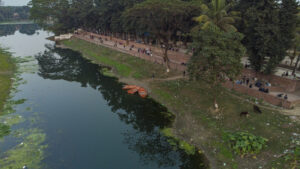
The riverbank development initiative by Sobai Mile Jhenaidah Gori movement. Source

Community-led design process. Source
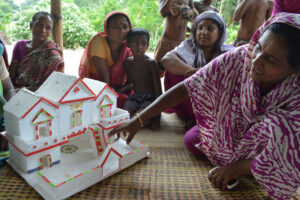
Women working on their own houses. Source
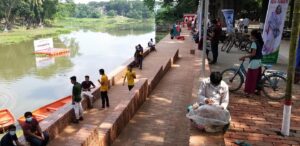
Vibrant open space at the redeveloped open space at Jhenaidah. Source
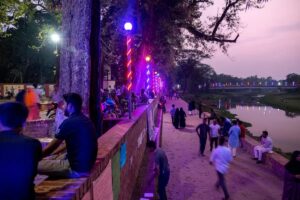
Jhenaidah community-led design at night. Source
